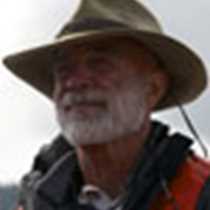Los Islotes, Isla Partida and Ensenada Grande
As soon as the Sea Lion left anchorage at 0530 in the morning, we knew that wind was going to play an important role in our day. The same wind that made the upwelling currents bring cold, nutrient-rich water to the surface and produced the plankton bloom we experienced yesterday, gave us an exciting ride down the waves to our morning stop at the island of Los Islotes. With rich morning light on this small, lusciously red volcanic island, the captain maneuvered the ship very close so that we could view the abundant wildlife there. First we were captivated by the vociferous California sea lions on the rocks as our naturalists explained their life history. Females, pups and males adorned the rocks and basked in the morning sun. Some of the pups were suckling and others were gathered in small groups while their mothers were out fishing and probably resting from parenthood. Soon, however, we broadened our scope to include the many seabirds roosting, courting and flying around the island. We watched with great interest as brown and blue-footed boobies crashed into the water around us, feeding on schooling fish and stealing well earned fish from each other.
After a few hours at Los Islotes, the Sea Lion again went south with the big seas to Isla Partida and Ensenada Grande. This most idyllic of bays is deeply etched into the beautiful, volcanic west coast of the island and is a great haven for vessels when the winds blow. Before snorkeling in the clear water of the bay, our Duke University lecturer gave us an overview of the geologic processes that created the Sea of Cortez and the mountains of the Sierra Madre Occidental that we will be visiting in a few days. During the afternoon we had a chance to explore the beautiful arroyo that forms the head of the bay and learn about the plants and animals that inhabit this place where the red hues of the desert meet the azure sea.
As soon as the Sea Lion left anchorage at 0530 in the morning, we knew that wind was going to play an important role in our day. The same wind that made the upwelling currents bring cold, nutrient-rich water to the surface and produced the plankton bloom we experienced yesterday, gave us an exciting ride down the waves to our morning stop at the island of Los Islotes. With rich morning light on this small, lusciously red volcanic island, the captain maneuvered the ship very close so that we could view the abundant wildlife there. First we were captivated by the vociferous California sea lions on the rocks as our naturalists explained their life history. Females, pups and males adorned the rocks and basked in the morning sun. Some of the pups were suckling and others were gathered in small groups while their mothers were out fishing and probably resting from parenthood. Soon, however, we broadened our scope to include the many seabirds roosting, courting and flying around the island. We watched with great interest as brown and blue-footed boobies crashed into the water around us, feeding on schooling fish and stealing well earned fish from each other.
After a few hours at Los Islotes, the Sea Lion again went south with the big seas to Isla Partida and Ensenada Grande. This most idyllic of bays is deeply etched into the beautiful, volcanic west coast of the island and is a great haven for vessels when the winds blow. Before snorkeling in the clear water of the bay, our Duke University lecturer gave us an overview of the geologic processes that created the Sea of Cortez and the mountains of the Sierra Madre Occidental that we will be visiting in a few days. During the afternoon we had a chance to explore the beautiful arroyo that forms the head of the bay and learn about the plants and animals that inhabit this place where the red hues of the desert meet the azure sea.




